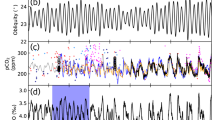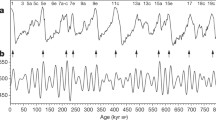Abstract
It was ascertained that the long-term cyclical oscillations of the global climate of the Earth between glacial and interglacial states for the last million years respond to cyclical oscillations of the orbital parameters of the Earth. Cold glacial states with a period of approximately 100 ka give way to shorter intervals of warming of around 10–12 ka long. The current interglacial period—the so-called Holocene—started on Earth roughly 10 ka ago. The length of the current interglacial period and the causes of the climate change over the last approximately 50 years arouse sharp debates connected with the growing anthropogenic emission of greenhouse gases. To estimate the length of the current interglacial period, interglacial intervals near ~400 (MIS-11) and ~800 (MIS-19) ka are analyzed as its probable analogs.
Similar content being viewed by others
References
Alley, R.B., The Younger Dryas cold interval as viewed from central Greenland, Quaternary Sci. Rev., 2000, vol. 19, no. 1, pp. 213–226.
Berger, A. and Loutre, M.F., Insolation values for the climate of the last 10 million years, Quaternary Sci. Rev., 1991, vol. 10, no. 4, pp. 297–317.
Berger, A. and Yin, Q., About past interglacials as analogues to the Holocene and Anthropocene, Geophys. Res. Abstracts, 2014, vol. 16, p. EGU2014–3326.
Dergachev, V.A. and Raspopov, O.M., Problem of the length of the current interglacial, Geomagn. Aeron. (Engl. Transl.), 2013, vol. 53, no. 7, pp. 876–881.
Hays, J.D., John Imbrie John, and Shackleton, N.J., Variations in the Earth’s orbit: Pacemaker of the ice ages, Science, 1976, vol. 194, no. 4270, pp. 1121–1132.
Jouzel, J., Masson-Delmotte, V., Cattani, O., et al., Orbital and millennial Antarctic climate variability over the past 800,000 years, Science, 2007, vol. 317, no. 5839, pp. 793–797.
Karabanov, E.B., Prokopenko, A.A., Kuz’min, M.I., et al., Glacial and interglacial periods of Siberia: Paleoclimate record of the Baikal Lake and its correlation with the West-Siberian stratigraphy, Geol. Geofiz., 2001, vol. 42, nos. 1–2, pp. 48–63.
Kotlyakov, V.M., On the causes and consequences of the current climate changes, Solnechno-Zemnaya Fiz., 2012, no. 21, pp. 110–114.
Lang, N. and Wolff, E.W., Interglacial and glacial variability from the last 800 ka in marine, ice and terrestrial archives, Clim. Past, 2011, vol. 7, pp. 361–380.
Laskar, J., Robutel, P., Joutel, F., Gastineau, M., Correia, A.C.M., and Levrard, B., A long term numerical solution for the insolation quantities of the Earth, Astron. Astrophys., 2004, vol. 428, pp. 261–285.
Lisiecki, L. and Raymo, M., A Pliocene–Pleistocene stack of 57 globally distributed benthic d18O records, Paleoceanography, 2005, vol. 20, p. A1003. doi: 10.1029/ 2004PA001071
Lüthi, D., Le Floch, M., Bereiter, B., et al. High-resolution carbon dioxide concentration record 650,000–800,000 years before present, Nature, 2008, vol. 453, pp. 379–382.
Marcott, S.A., Shakun, J.D., Clark, P.U., and Mix, A.C., A reconstruction of regional and global temperature for the past 11,300 years, Science, 2013, vol. 339, no. 6124, pp. 1198–1201.
Meltzer, D.J., Holliday, V.T., Cannon, M.D., and Miller, D.S., Chronological evidence fails to support claim of an isochronous widespread layer of cosmic impact indicators dated to 12,800 years ago, Proc. Natl. Acad. Sci. USA, 2014, vol. 111, no. 21, pp. E2162–E2171.
Shakun, J.D., Clark, P.U., and He, F., Global Warming preceded by increasing carbon dioxide concentrations during the last deglaciation, Nature, 2012, vol. 484, pp. 49–54.
Tzedakis, P.C., Channell, J.E.T., Hodell, D.A., Kleiven, H.F., and Skinner, L.C., Determining the natural length of the current interglacial, Nature Geosci., 2012, vol. 5, pp. 138–141.
Vakulenko, N.V. and Sonechkin, D.M., Evidence of the upcoming end of the contemporary interglacial, Dokl. Earth Sci., 2013, vol. 452, no. 1, pp. 926–929.
Wu, H., Sharma, M., LeCompte, M.A., Demitroff, M.N., and Landis, J.D., Origin and provenance of spherules and magnetic grains at the Younger Dryas boundary, Proc. Natl. Acad. Sci. USA., 2013, vol. 110, no. 38, pp. E3557–E3566.
Zachos, J., Pagani, M., Sloan, L., Thomas, E., and Billups, K., Trends, rhythms, and aberrations in global climate 65 Ma to present, Science, 2001, vol. 292, pp. 686–693.
Zachos, J., Dickens, G.R., and Zeebe, R.E., An early Cenozoic perspective on greenhouse warming and carboncycle dynamics, Nature, 2008, vol. 451, pp. 279–283.
Author information
Authors and Affiliations
Corresponding author
Rights and permissions
About this article
Cite this article
Dergachev, V.A. Length of the current interglacial period and interglacial intervals of the last million years. Geomagn. Aeron. 55, 945–952 (2015). https://doi.org/10.1134/S0016793215070051
Received:
Accepted:
Published:
Issue Date:
DOI: https://doi.org/10.1134/S0016793215070051




